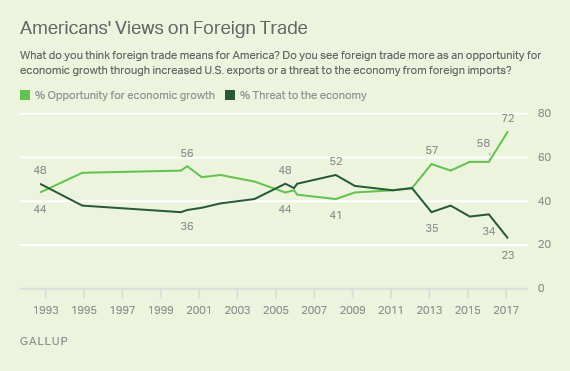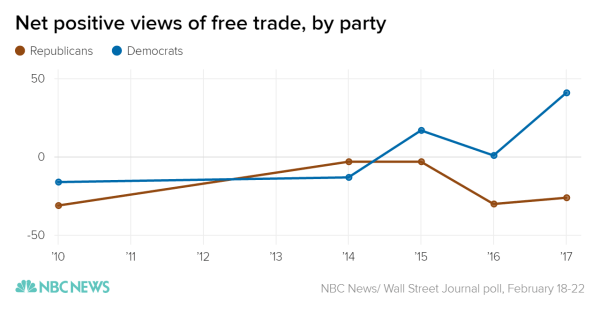The McCormick reaper is one of the primary labor-saving inventions of the early 19th century, and at a time when many people are expressing concerns about how modern machines are going to make large numbers of workers obsolete, it's a story with some lessons worth remembering. Karl Rhodes tells the story of the arguments over who invented the reaper and the wars over patent rights in "
Reaping the Benefits of the Reaper," which appears in the
Econ Focus magazine published by the Federal Reserve Bank of Richmond (Third/Fourth Quarter 2016, pp. 27-30). Here, I'll lay out some of the lessons which caught my eye, which in places will sound similar to modern issues concerning innovation and intellectual property.
The reaper was important, but it didn't win the Civil War
The reaper was a horse-drawn contraption for harvesting wheat and other grains. Rhodes quotes the historian William Hutchinson who wrote: "Of all the inventions during the first half of the nineteenth century which revolutionized agriculture, the reaper was probably the most important," because it removed the bottleneck of needing to hire lots of extra workers at harvest time, and thus allowed a farmer "to reap as much as he could sow."
But somewhere along the way, I had imbibed a larger myth, that the labor saving properties of the reaper helped the North to with the Civil War by allowing young men who would otherwise have been needed for the harvest to become soldiers. However, Daniel Peter Ott in a 2014 PhD dissertation on "
Producing a Past: Cyrus McCormick's Reaper from Heritage to History." Ott traces the claim that the reaper helped to win the Civil War back to some
promotional materials for the centennial celebration of the reaper in 1931 produced by International Harvester which included this statement:
"Secretary of War Stanton said: ‘The reaper is to the North what slavery is to the
South. By taking the place of regiments of young men in western harvest fields, it
released them to do battle for the Union at the front and at the same time kept up
the supply of bread for the nation and the nation’s armies. Thus, without
McCormick’s invention I feel the North could not win and the Union would have
been dismembered.’"
Ott argues persuasively that this quotation is incorrect. Apparently, Edwin Stanton was a patent attorney before he became Secretary of War for President Lincoln, and he was arguing in court in 1861 that McCormick's reaper deserved an extension of his patent term. Ott quotes a 1905 biography of
Edwin Stanton, written by Frank A. Flower, which included the following quotation attributed to an 1861 patent case, in which Stanton argued:
"The reaper is as important to the North as slavery to the South. It takes the place
of the regiments of young men who have left the harvest fields to do battle for the
Union, and thus enables the farmers to keep up the supply of bread for the nation
and its armies. McCormick’s invention will aid materially to prevent the Union
from dismemberment, and to grant his prayer herein is the smallest compensation
the Government can make."
There doesn't seem to be any documentary evidence directly from the 1860s on what Stanton said. But it appears plausible that the he argued as a patent attorney in 1861 that the McCormick reaper deserved a patent because it could help to with the Civil War, and that comment was later transmuted by a corporate public relations department into a claim that Secretary of War Stanton credited the reaper with actually winning the Civil War.
New innovations can bring conflict over intellectual property
Oded Hussey patented a reaper in 1833. Cyrus McCormick patented a reaper in 1834. By the early 1840s, Hussey had sold more reapers than McCormick. But the idea of a mechanical reaper had been in the air for some time.
Joseph Gies offered some background in "The Great Reaper War," published in the Winter 1990 issue of Invention & Technology. Gies wrote:
"In 1783 Britain’s Society for the Encouragement of Arts, Manufactures, and Commerce offered a gold medal for a practical reaper. The idea seemed simple: to use traction, via suitable gearing, to provide power to move some form of cutting mechanism. By 1831 several techniques had been explored, using a revolving reel of blades, as in a hand lawn mower; a rotating knifeedged disk, as in a modern power mower; and mechanical scissors. Robert McCormick had tried using revolving beaters to press the stalks against stationary knives. Cyrus McCormick and Obed Hussey both chose a toothed sickle bar that moved back and forth horizontally. Hussey’s machine was supported on two wheels, McCormick’s on a single broad main wheel, whose rotation imparted motion to the cutter bar. Wire fingers or guards in front of the blade helped hold the brittle stalks upright."
"A few words in reply to the Tribune-McCormick "facts," which are assumed to justify the proposed extension. The first two of these may be summed up as follows: The patentee failed to secure extensions of his first two patents -- and, therefore, his original invention and improvements covered by his first and second patents are free by all mankind Granted; and we claim that for the precise reasons which led to the rejection of his petitions for the extension of his original patents, his now pending petition should be treated in the same manner. Those reasons were that the "improvements" are non-essential, and that the patentee has received ample remuneration for his invention.
But, says Mr. MCCORMICK, "OBED HUSSEY obtained an extension of his patent, and therefore mine should also be extended." Two wrongs never yet made one right; and it was the fact that HUSSEY's patent was renewed by the late acting Commissioner, unjustifiably, which, more than anything else, induced Congress to take the McCormick case out of his hands. The public were wronged in the Hussey case; and it is therefore still more incumbent upon the Patent Office to see to it that another wrong is not added to the list. ... It is notorious that MCCORMICK will have made over $2,000,000 on his reapers by the time his present patents shall have expired, and as the new Commissioner of Patents has a reputation for honesty to maintain, there is little danger that the monopoly will be renewed."
Indeed, the arguments over reaper patents from the 1840s up into the early 1860s were some of the early battles in what is sometimes called
"the first patent litigation explosion." One early result was that the Patent Act of 1861 removed the discretionary power of the Patent Office to extent patents by seven years at a time, and instead created the 17-year patent term.
Innovations can take decades before coming into widespread use
Although versions of the reaper were patented in the first half of the 1830s, they didn't come into widespread use until the 1850s and later. Why not? A body of research in economic history tackled that question several decades ago, and Rhodes provides a nice compact summary of how thinking on this question evolved:
The traditional explanation for this surge in sales was the rapid rise of global wheat prices during the Crimean War, which limited grain exports from Russia and other nations in the Black Sea region. But in the 1960s, Stanford University economist Paul David offered another primary explanation: He argued that before the mid-1850s, most American farms were simply too small to make reapers practical.
The average farm size was growing, however, as grain production shifted from the East to the Midwest, where arable land was fresh, fertile, and relatively flat. More importantly, the farm-size threshold for the reaper to be practical was declining as the price of labor — relative to the price of reaping machines — increased in the Midwest due to higher demand for workers to build railroads and other infrastructure throughout the fast-growing region, David wrote.
In the 1970s, Alan Olmstead, an economist at the University of California, Davis, agreed that factor prices and farm sizes were important, but he argued that ... [f]armers often cooperated to use reapers on multiple farms, a possibility that David had excluded from his model. Olmstead also faulted David for assuming that there were no significant advances in reaper technology between 1833 and the 1870s. This assumption that the reaper was born fully developed grew into a "historical fact," Olmstead wrote, even though it ignored "extremely knowledgeable historians who emphasized how a host of technological changes transformed an experimentally crude, heavy, unwieldy, and unreliable prototype of the 1830s into the relatively finely engineered machinery of the 1860s."
For those who would like to go back to original sources, Paul David's article was "The Mechanization of Reaping in the Ante-Bellum Midwest," published in a 1966 volume edited by Henry Rosovsky, ,
Industrialization in Two Systems: Essays in Honor of
Alexander Gerschenkron, pp. 3-39. Alan L. Olmstead's essay is "The Mechanization of Reaping and Mowing in American Agriculture, 1833-1870," in the June 1975 issue of the
Journal of Economic History, pp. 327-352.
The slow diffusion of technology is a widespread finding: for example, I've posted on this blog about the examples of tractors and dynamo-generated electrical power in
"When Technology Spreads Slowly" (April 14, 2014). It's a useful warning and reminder to those who seem to believe, often implicitly, that the internet and data revolution is pretty much over at this point, and we've seen pretty much all the changes we're going to see.
Entrepreneurship isn't just about technology, but also needs marketing, manufacturing, and continual improvement
Why is the reaper often known in the history books as the "McCormick reaper," when Hussey patented first. The answer from shows up in the subtitles of articles. For example, Rhodes subtitles his article: "Cyrus McCormick may not have invented the reaper, but he was the entrepreneur who made it successful." Similarly, Gies writes in the subtitle of his 1990 article: Cyrus McCormick won it—his famed Virginia reaper came to dominate America’s harvests—but he didn’t win by building the first reaper or, initially, the best."
But McCormick shows a persistent entrepreneurial drive. He moved to Chicago, so that his reapers would have better access to markets in the midwest and west, leaving the eastern market to Hussey. He continually improved the reaper. He pushed ahead on manufacturing and marketing. Rhodes writes:
But based on overlapping information from sources cited by both sides of the family, it seems likely that Cyrus and Robert both contributed to the McCormick reaper of 1831. And so did their slave, Jo Anderson, and so did a local blacksmith, John McCown. It also seems possible that Cyrus and Robert obtained knowledge of previous attempts to develop a practical reaper. ,,, [But] who supplied the entrepreneurial power that brought the reaper into common use? And the answer is clearly Cyrus McCormick."

























